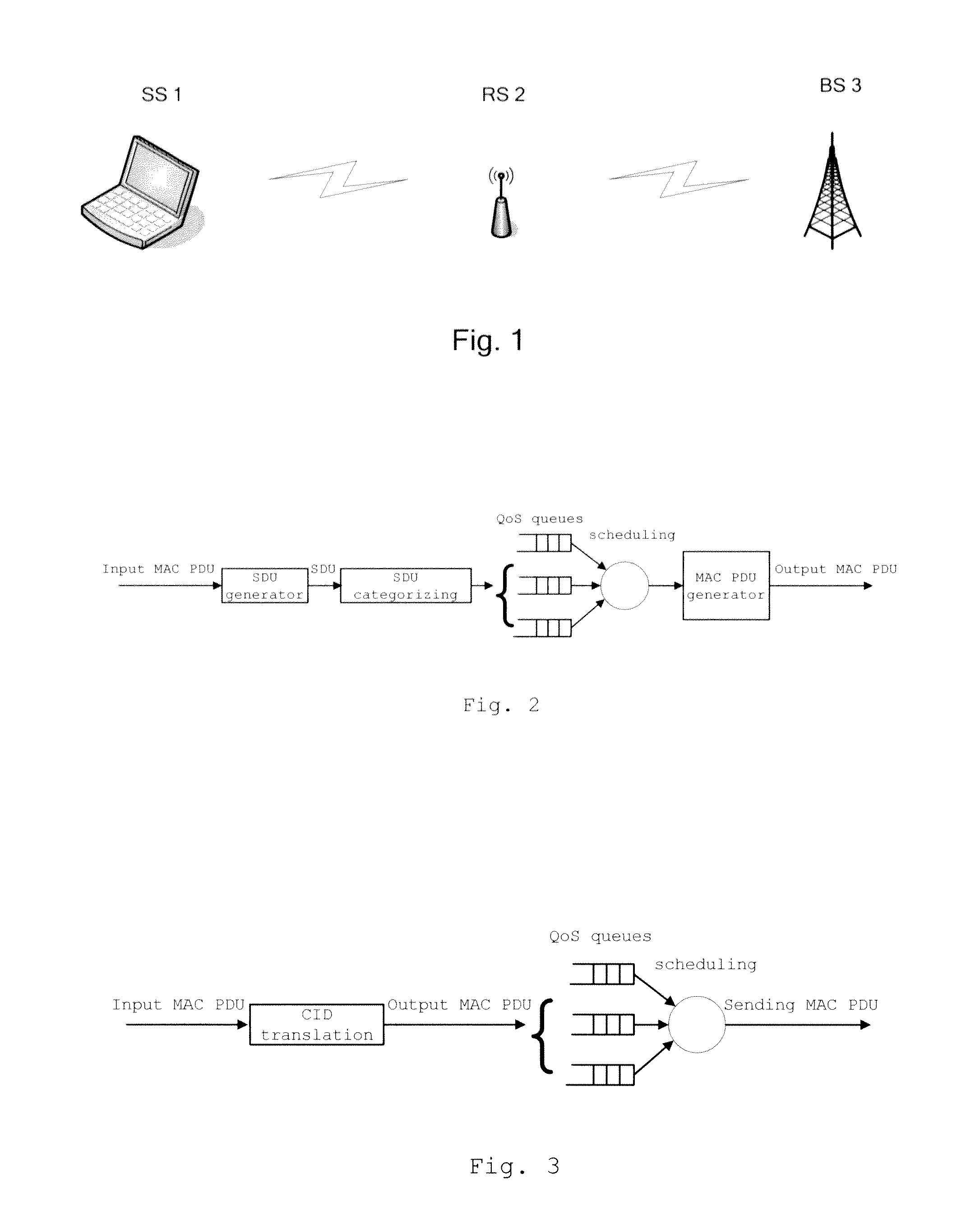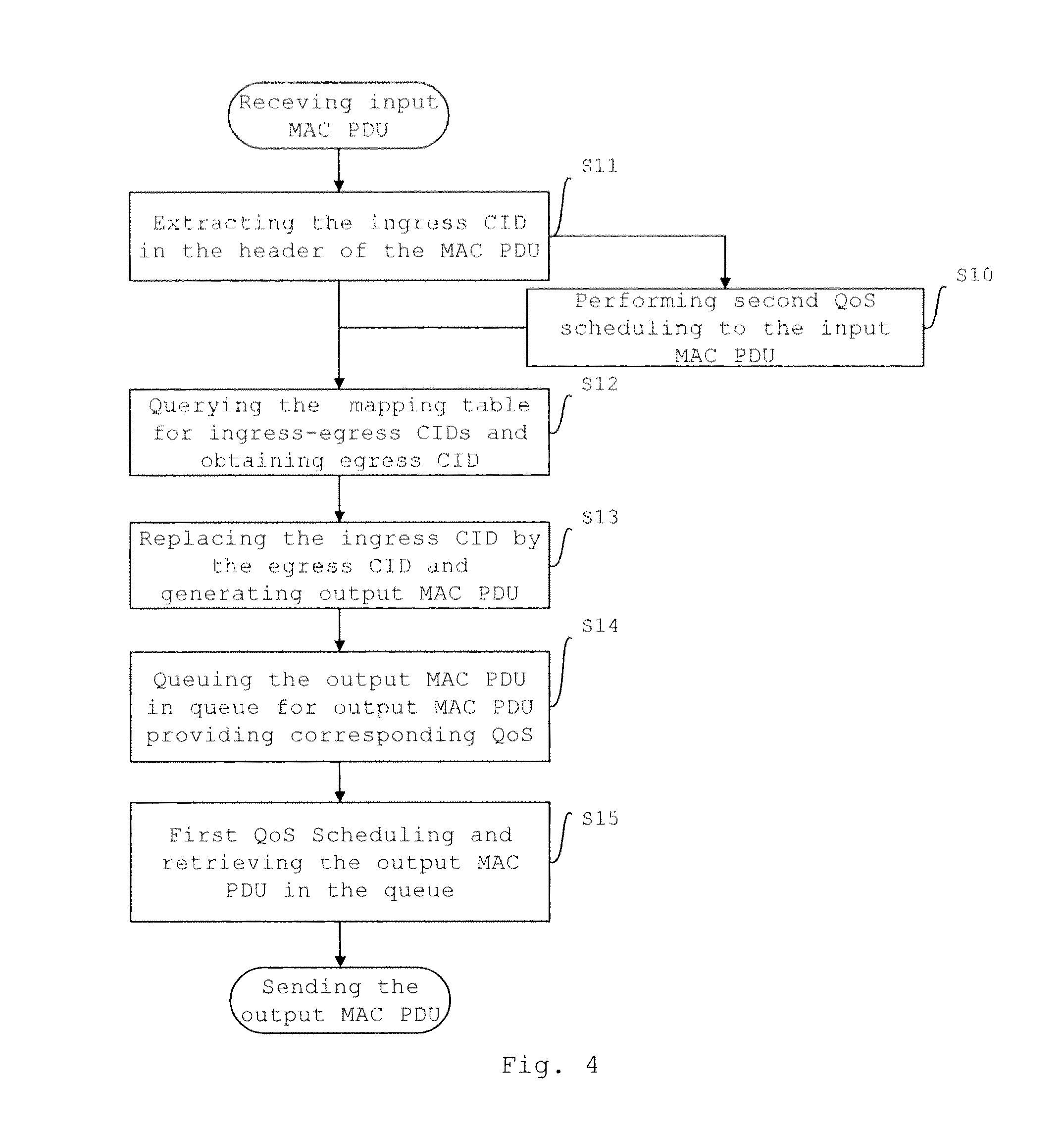Method and device for data relay transmission in wireless relay network
a wireless relay and wireless relay technology, applied in the field of wireless relay communication, can solve the problems of large latency of relay transmission, increase of data from the source to the destination, through the transmission via multiple relay stations, etc., and achieve the effect of improving the qos service performance of the relay station and canceling the waiting latency
- Summary
- Abstract
- Description
- Claims
- Application Information
AI Technical Summary
Benefits of technology
Problems solved by technology
Method used
Image
Examples
first embodiment
[0032]FIG. 4 is a flowchart of the method for data relay transmission in relay stations, according to the invention. The invention will be described in the following part in details by referring to this figure accompanied with FIG. 1 and FIG. 3.
[0033]Specifically, in step S11, the RS extracts the ingress CID information, such as ingress CID=0x18, from the header of the input MAC PDG, which entered the RS;
[0034]After that, in step S12, the RS takes the extracted ingress CID=0x18 as an index, and queries a mapping table for ingress-egress CIDs, which is pre-stored in the RU, so as to obtain the egress CID corresponding to the ingress CID.
[0035]Wherein, the mapping table for ingress-egress CIDs is a mapping table stored in the RS, which identifies the mapping relationship from one or more ingress CIDs to one or more egress CIDs. The table comprises an ingress CID list and an egress CID list, and defines the mapping relationship from ingress CID to egress CID. According to the number of...
second embodiment
[0047]FIG. 8 is a flowchart of the method for data relay transmission in relay stations, according to the invention. The invention will be described in the following part in details by referring to this figure accompanied with FIG. 1 and FIG. 3.
[0048]Specifically, in this embodiment, step S21 and step S22 are the same as step S11 and step 112 in the if first embodiment, and will not be described here. For example, the ingress CID-0x18 the input MAC 000 header is extracted via step 121, and egress CID-0x3f is obtained via step S22.
[0049]After that, the relay station uses the method of tunneling encapsulation, and adds a new header to the input MAC Pal for tunneling encapsulation. As shown in FIG. 9, the relay station embeds the egress CID-0x3f into the new header after the encapsulation, so as to generate an encapsulated output MAC PDU. In case that correction bits (including HCS for header correction and / or CRC data correction bits) is contained in the MAC PDU, it is necessary to re...
third embodiment
[0050]FIG. 10 is a flowchart of the method for data relay transmission in relay stations, according to the invention. The invention will be described in the following part in details by referring to this figure accompanied with FIG. 1 and FIG. 3.
[0051]The subheader of the input MAC PDU comprises a group of CIDs, which includes one or more egress CIDs corresponding to one or more relay hops of the transmission path for the input MAC PDU. In step S31, the relay station extracts the ingress CID information from the header of the input MAC. PDU, and extracts the group of CIDs from the subheader of the input MAC PDU. The extracted group of CIDs includes one or more egress CIDs corresponding to one or more relay hops of the transmission path for the input MAC PDU.
[0052]After that, in step S32, the relay station extracts the CID corresponding to the present relay hop from the group of CIDs, and takes this CID as the egress CID.
[0053]Then, in step S33, the relay station moves the ingress CI...
PUM
 Login to View More
Login to View More Abstract
Description
Claims
Application Information
 Login to View More
Login to View More - R&D
- Intellectual Property
- Life Sciences
- Materials
- Tech Scout
- Unparalleled Data Quality
- Higher Quality Content
- 60% Fewer Hallucinations
Browse by: Latest US Patents, China's latest patents, Technical Efficacy Thesaurus, Application Domain, Technology Topic, Popular Technical Reports.
© 2025 PatSnap. All rights reserved.Legal|Privacy policy|Modern Slavery Act Transparency Statement|Sitemap|About US| Contact US: help@patsnap.com



